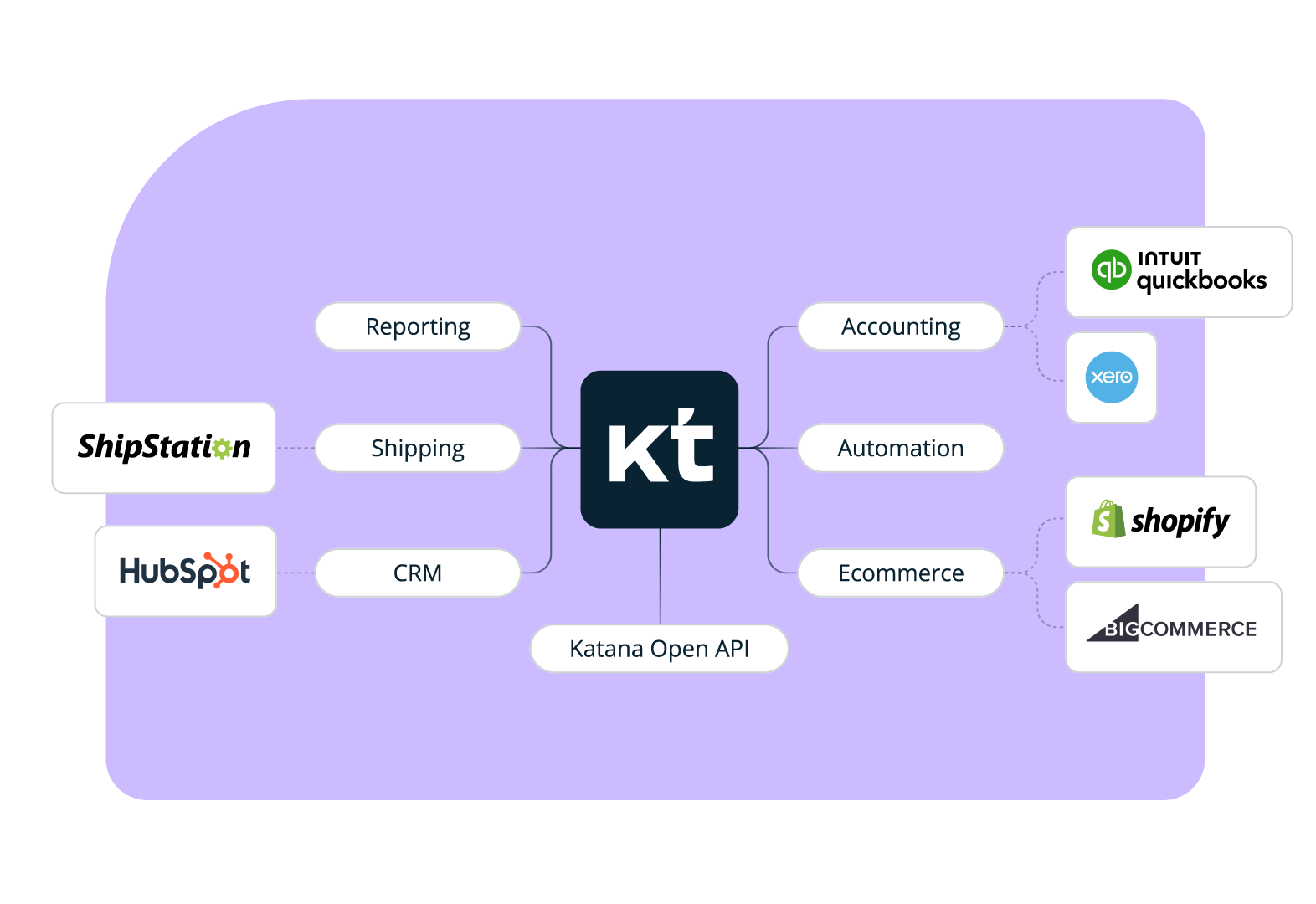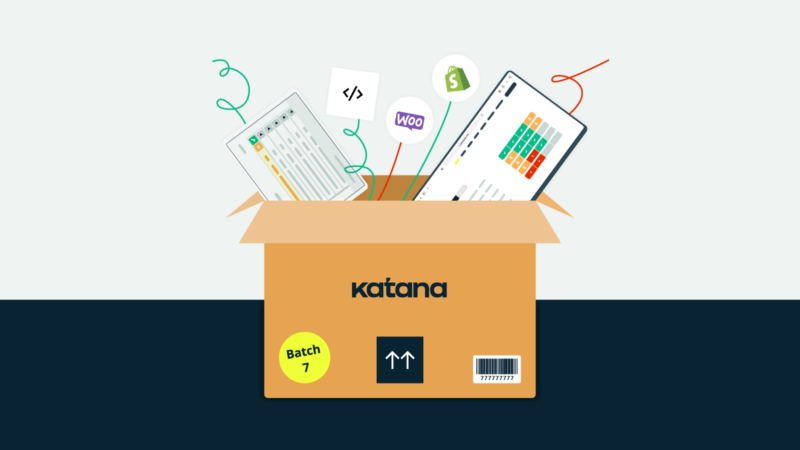What is inventory management API?
Understand what an API is, why it is important, what benefits it brings, and how it powers a variety of operations and features that can empower and support your business to level up.

Ioana Neamt

API has been an integral part of our daily lives in countless ways, powering everything from how we get weather reports to how we shop online, book trips, get directions through our map apps, and so much more. APIs are essential tools that enable software to communicate effortlessly across the globe, driving business and innovation in today’s digital economy.
Enterprise software, manufacturing, inventory management, and ecommerce are no different — they all work together much better when connected through powerful tools such as API.
What is an API?
API, or application programming interface, is a set of rules that allows one software program to communicate with another. It acts like a messenger that takes requests, tells a system what you want to do, and then returns the response. APIs let different systems work together, like how apps on your phone interact with web services to fetch data. APIs are what make integrations possible, which, as we know, saves a lot of headaches in the kind of complex interconnected operations we run today.

What are the benefits of using an API?
APIs are essential to the way we do business today, the platforms we use, and how they compete for our everyday convenience. There are many benefits, both for software developers and businesses that use that software extensively. Let’s go over a few of the main benefits of each.
3 key API benefits for developers
- Innovation — This bridge-building technology allows developers to create new connections and develop new applications that better answer the needs of evolving businesses.
- Adaptability — As an API uses standardized protocols, it can be adapted and reused relatively easily to build new applications, which can add up to significant savings in time and effort.
- Simplified development — An API can take dealing with complex underlying systems off your plate, which also translates to more efficient use of time and other resources.
3 key API benefits for businesses
- Efficiency — APIs make it possible to automate several tasks and processes, which helps streamline workflows and increase efficiency and productivity.
- Seamless integrations — Build your business across multiple channels and easily gather data from all the moving parts of your business, to support your decision-making process with data-driven analysis and insights.
- Elevates customer experience — With the use of API, you can offer customers a personalized experience, provide accurate and up-to-date information on inventory levels, and build a reliable reputation.
Katana API
Katana Cloud Inventory Platform offers prebuilt integrations as well as an open API, enabling you to create your own custom workflows.
What is an API for inventory management?
API for inventory management enables your business to connect inventory software to other applications. Examples include ecommerce platforms, point-of-sale systems, and supply chain management software. Leveraging inventory management APIs can help you optimize your inventory, its movements, and the policies associated with it, as well as streamline operations and reduce costs.
Key functions and features of inventory management API
But what exactly can inventory management API do for you? The list of helpful functionalities runs long, and you might be surprised how many of them you have come to take for granted and even expect as a bare minimum standard, today.

Integrations
Perhaps the most important functionality of API in inventory management is that it facilitates integrations with ecommerce platforms, point-of-sale systems, ERP systems, and more, for a seamless data flow between them.
Real-time inventory updates
Stemming from a successful integration, you can automatically sync your inventory levels across different systems. This ensures the information you are working with is accurate and up-to-date across the board.
Inventory level monitoring
An inventory management system uses API to gather real-time data on inventory from various sources, such as a warehouse management system or a point of sale. This should be very helpful for you to avoid stockouts and overstocking.
Warehouse management integration
API can connect an inventory management platform with a warehouse management system, which can help you optimize your storage and retrieval processes for enhanced efficiency.
Automation of order fulfillment tasks
APIs also facilitate the automatic processing of orders, subsequent updates to inventory levels, and the generation of shipping labels.
Demand forecasting
Managing data from multiple sources in real-time elevates your ability to analyze historical data in order to predict future demand and use that insight to optimize your inventory levels.

How does inventory management API work?
APIs are a set of standards for how applications can interact with servers to retrieve, create, update, and delete data. These powerful tools can be leveraged in inventory management to add functionality, build custom workflows, and optimize processes. Let’s look at three examples of how inventory management API works.
Order fulfillment
- A customer searches for an item on an ecommerce platform that your inventory management system is integrated with.
- The ecommerce platform sends a request to the inventory management API to check if the product is available.
- The API retrieves the current inventory level for the product in question from your inventory management application.
- If the product is available, the API updates the inventory level to reflect the customer order that was made (the update subtracts the quantity that was ordered from your inventory levels).
- The API then sends a response to the ecommerce platform to indicate that the order can be fulfilled.
- Alternatively, if the product is not in stock, the API sends the appropriate response to the ecommerce platform. At the same time, it can handle a reordering protocol to fix the stockout.
Stock replenishment
- The inventory management system continuously monitors the stock level of the product across all your storage locations by using APIs to retrieve information in real time from various sources.
- When the inventory level reaches the previously defined reorder point, the system triggers a replenishment order as per your protocols.
- Using APIs to integrate with a purchasing system, you then automatically generate a purchase order for a predefined quantity of the product.
- The purchase order is sent to the supplier. APIs can facilitate communication via email or electronic data interchange (EDI).
- Ideally, the supplier confirms the order and provides an estimated delivery date
- Using APIs to integrate with shipping carriers, your system can track the order from the supplier to your warehouse.
- Upon arrival, the shipment is received and inspected for quality and quantity.
- APIs then update inventory levels across your system in real time, maintaining a high level of accuracy.
HubSpot partner looking to expand your value offering?
Provide your clients with an end-to-end inventory solution that integrates seamlessly with HubSpot.
BOM management
- The product design team creates a detailed bill of materials (BOM) for a new product. The BOM details the required components, as well as the quantities and specifications for each.
- If the bill of materials software is integrated with your inventory management system using APIs, your system can easily check the current inventory levels of each component specified in the BOM.
- If any of the required components are missing or are available in insufficient quantities, the system can automatically generate purchase orders to replenish the inventory.
- Bill of materials (aka product recipe) data can be used to create production plans and schedule the assembly of the product based on component availability and production capacity — information exchanges facilitated by API.
- With the help of APIs, you can also easily track the progress of production to monitor component usage and identify any potential issues.
- As components are consumed during the making of the products, this information can be communicated through APIs to the inventory management system for real-time updates.
- Once the product is completed, an API helps pass this information on to add it to the finished goods inventory levels and subtract the corresponding BOM components from the raw materials inventory.
Explore the possibilities of inventory management API with Katana
Using APIs can help you automate a variety of processes, which would translate to benefits that include accurate BOM management, efficient inventory replenishment, effective production planning, improved operational efficiency, and reduced costs. If you want to take your business to the next level while saving time spent on repetitive tasks and reducing the incidence of errors, consider the possibilities of Katana API solutions:
- Easily integrate your production operations with your ecommerce systems
- Automate BOM inventory management
- Import sales orders automatically from multiple ecommerce platforms
- Seamlessly sync your inventory data with a wide array of ecommerce, shipping, accounting, and reporting platforms
- Connect all your tools to give everyone in your team — from managers to sales teams and shop floor employees — real-time access to the information they need to work effectively
- Make the most of our native integration options to connect your business to some of the best ecommerce and CRM platforms available
- Go beyond that and build custom workflows with Katana’s open API to tailor the benefits of this powerful tool to your exact needs
Book a demo and get our inventory management experts to show you all the ways Katana can improve your business.
FAQs
Application programming interface (API) in inventory management connects your inventory data with other applications, systems, and platforms to streamline the flow of data across all aspects of your business. Native integration, as well as open API solutions like that offered by Katana, make it easy to tailor this technology to support the growth of your business while saving time and other resources.
APIs are categorized mainly by use case and by protocol. Use case types include:
- Open APIs — Usable by anyone to access the source’s information
- Internal APIs — Facilitate information flow between internal apps
- Partner APIs — Tailor-made for connecting with third-party developers/partners
API types defined by protocol include:
- REST API
- SOAP API
- GraphQL API
- Webhook API
To put it simply, an API acts as a conduit of information between applications, devices, and systems, and works through a cycle of request and response that is defined and limited through standardized protocols and programming. Depending on what the API is supposed to do, it can be a relatively simple process or a highly complex one.

Ioana Neamt
Table of contents
Get inventory trends, news, and tips every month
Get visibility over your sales and stock
Wave goodbye to uncertainty with Katana Cloud Inventory — AI-powered for total inventory control